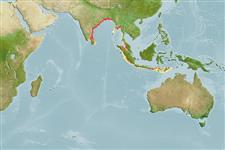Common names from other countries
Teleostei (teleosts) >
Gobiiformes (Gobies) >
Oxudercidae (Mudskippers) > Periophthalminae
Etymology: Periophthalmus: Greek, peri = around + Greek, ophthalmos = eye (Ref. 45335).
More on author: Hamilton.
Environment: milieu / climate zone / depth range / distribution range
Ecology
Marine; brackish; demersal; amphidromous (Ref. 51243). Tropical
Indian Ocean: India.
Size / Weight / Age
Maturity: Lm ? range ? - ? cm
Max length : 10.0 cm SL male/unsexed; (Ref. 4833)
Dorsal spines (total): 9 - 11; Dorsal soft rays (total): 11 - 12; Anal spines: 1; Anal soft rays: 12 - 13. This is a sexually dimorphic species, with males possessing greatly elongate first spine of first dorsal fin, reaching eighth element of second dorsal fin when appressed; when preserved first dorsal fin brown or black with white distal edge, no spots; margin of first dorsal fin concave in males while concave to straight in females; second dorsal fin with two black bands, broader one located inframarginally and the other located medially, black spots basally on membrane between dorsal fin elements; pelvic fin with prominent frenum and inner rays fused for more than half of length. D1 modally IX; D2 modally I,12; A modally I,13; caudal fin rays modally 15 segmented rays, with first and last two rays unbranched; 62-67 lateral scale rows; 18-24 predorsal scales (Ref. 83659).
Facultative air-breathing (Ref. 126274); An intertidal and amphibious air-breather that actively shuttles back and forth between rock pools and air (Ref. 31184).
Life cycle and mating behavior
Maturities | Reproduction | Spawnings | Egg(s) | Fecundities | Larvae
Murdy, E.O., 1989. A taxonomic revision and cladistic analysis of the oxudercine gobies (Gobiidae: Oxudercinae). Rec. Aust. Mus., Suppl. 11:1-93. (Ref. 5218)
IUCN Red List Status (Ref. 130435)
CITES (Ref. 128078)
Not Evaluated
Threat to humans
Harmless
Human uses
Fisheries: of no interest
Tools
Special reports
Download XML
Internet sources
Estimates based on models
Preferred temperature (Ref.
115969): 27.6 - 29.4, mean 28.6 (based on 192 cells).
Phylogenetic diversity index (Ref.
82804): PD
50 = 0.5000 [Uniqueness, from 0.5 = low to 2.0 = high].
Bayesian length-weight: a=0.01072 (0.00667 - 0.01721), b=2.91 (2.77 - 3.05), in cm Total Length, based on LWR estimates for this species & Genus-body shape (Ref.
93245).
Trophic level (Ref.
69278): 3.2 ±0.4 se; based on size and trophs of closest relatives
Resilience (Ref.
120179): High, minimum population doubling time less than 15 months (Preliminary K or Fecundity.).
Fishing Vulnerability (Ref.
59153): Low vulnerability (10 of 100).
